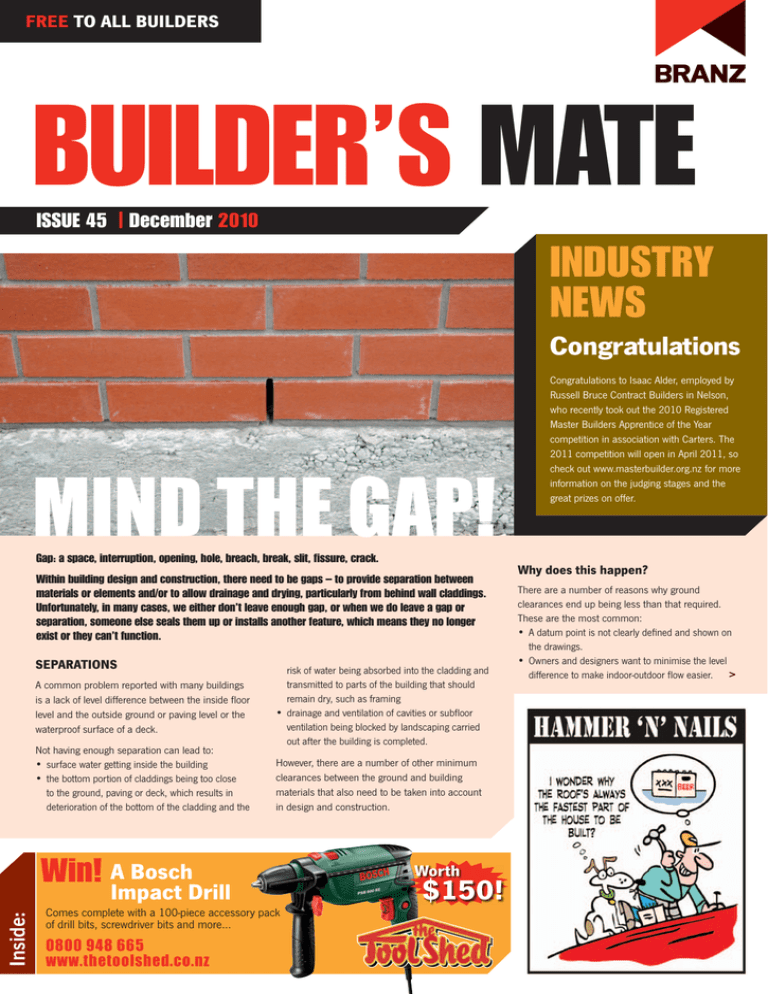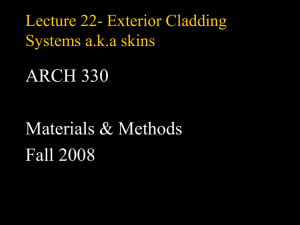advertisement

FREE TO ALL BUILDERS BUILDER’S MATE ISSUE 45 | December 2010 INDUSTRY NEWS Congratulations MIND THE GAP! Gap: a space, interruption, opening, hole, breach, break, slit, fissure, crack. Within building design and construction, there need to be gaps – to provide separation between materials or elements and/or to allow drainage and drying, particularly from behind wall claddings. Unfortunately, in many cases, we either don’t leave enough gap, or when we do leave a gap or separation, someone else seals them up or installs another feature, which means they no longer exist or they can’t function. SEPARATIONS A common problem reported with many buildings is a lack of level difference between the inside floor level and the outside ground or paving level or the waterproof surface of a deck. Not having enough separation can lead to: •surface water getting inside the building •the bottom portion of claddings being too close to the ground, paving or deck, which results in deterioration of the bottom of the cladding and the risk of water being absorbed into the cladding and transmitted to parts of the building that should remain dry, such as framing •drainage and ventilation of cavities or subfloor ventilation being blocked by landscaping carried out after the building is completed. However, there are a number of other minimum clearances between the ground and building materials that also need to be taken into account in design and construction. Win! A Bosch Inside: Impact Drill Comes complete with a 100-piece accessory pack of drill bits, screwdriver bits and more... 0800 948 665 www.thetoolshed.co.nz Worth $150! Congratulations to Isaac Alder, employed by Russell Bruce Contract Builders in Nelson, who recently took out the 2010 Registered Master Builders Apprentice of the Year competition in association with Carters. The 2011 competition will open in April 2011, so check out www.masterbuilder.org.nz for more information on the judging stages and the great prizes on offer. Why does this happen? There are a number of reasons why ground clearances end up being less than that required. These are the most common: •A datum point is not clearly defined and shown on the drawings. •Owners and designers want to minimise the level difference to make indoor-outdoor flow easier. > > Continued from previous page •The initial site survey did not clearly identify the level differences across the site – while a site may appear flat, there can be enough level difference across the area of the building to compromise set-out if not enough spot levels are taken. •The set-out of the finished slab level relative to adjacent ground levels (either at design or on site) did not make sufficient allowance for the required separations. •Paths are laid and gardens are built up (usually) after the building is completed. •The building is built against or close to a bank that slopes towards the building. What is required? Minimum clearances are given in NZS 3604 and E2/AS1. Designers and builders will also need to be aware of specific requirements given by product manufacturers for clearances: •at the base of claddings •for treated plywood flooring •between the bottom of an internal sheet lining and the floor (typically 10 mm for plasterboard) •between the flooring and the wall framing for a post-laid timber board floor to allow for movement in the flooring. ENGINEERED GAPS Specifically designed gaps or openings are incorporated into building design to allow: • any water that might have got in through a cladding, specific detail or window to drain back out •air to get in to dry out moisture remaining behind a cladding after the water has got in •air to get in to allow pressure moderation particularly across the cladding and around the windows to occur •ventilation of the space under a suspended floor • separation between a flexible roof underlay and roof insulation to prevent the transference of moisture. There are minimum clearance requirements between the bottom of the cladding and the adjacent natural ground or paving. NZS 3604 Situation Gap required Bearer framing to ground 150 mm minimum if dpc between the pile and the bearer, otherwise 300 mm minimum Minimum crawl space to provide access for visual inspection of subfloor framing 450 mm Pile heights to ground with dpc 150 mm minimum Timber pile height to ground without dpc 300 mm minimum Lowest point of subfloor brace fixing to ground 200 mm minimum (300 mm maximum) Height of foundation wall above finished unprotected ground level 225 mm minimum (Note: Figure 6.21 of NZS 3604 gives the minimum height as 250 mm) Particleboard or fibreboard flooring to ground 550 mm Suspended floor adjacent to a bank (see NZS 3604 200 mm minimum from unprotected ground to Figure 6.21) cladding (Note that this is different from E2/AS1) Horizontal separation between bottom of cladding and adjacent bank 450 mm minimum Brick veneer cavity 40 mm minimum (BRANZ recommends 50 mm) to 75 mm maximum Slab rebate for masonry veneer 50 mm minimum Between top of veneer and soffit or cantilevered floor framing above 10 mm minimum to allow for timber wall framing shrinkage and ventilation Anti-capillary break between the back of the bottom edge of a direct-fixed cladding and the foundation wall 6 mm E2/AS1 Situation Gap required Finished concrete slab level to unprotected ground for masonry veneer 150 mm minimum (Where a 100 mm slab rebate is provided instead of the 50 mm minimum typically detailed in NZS 3604, Figure 7.10 of NZS 3604 requires a minimum of 25 mm between the base of the rebate and the top of the paving. Where there is no paving, NZS 3604 clause 7.5.2.1 requires a 150 mm minimum distance between floor level and outside ground level, which means there should be 50 mm between the bottom of the rebate and the finished ground level) Finished concrete slab level to paving for masonry veneer with 50 mm slab rebate 100 mm minimum (Note that the bottom of the veneer must be a minimum of 25 mm above the paving where the rebate is more than 50 mm and the slab floor level must be a minimum of 150 mm above unprotected ground) Finished concrete slab level to unprotected ground other than masonry veneer 225 mm minimum (This gives a cladding to unprotected ground clearance of 175 mm minimum) Finished concrete slab level to paving other than masonry veneer 150 mm minimum (This gives a cladding to ground clearance of 100 mm minimum) Adjacent floor level to an accessible waterproof deck 100 mm minimum Adjacent floor level to timber cantilevered slatted deck surface 50 mm minimum Floor level to timber non-cantilevered slatted deck 0 mm Garage floor slab to paving 50 mm minimum (minimum required cladding to ground clearance will need to be achieved to ensure product warranty) Base of cladding to apron flashing or membrane deck 35 mm minimum Cladding to head or inter-storey flashing 5 mm to allow drainage and drying Drained and vented cavity 20 mm minimum nominal (18–25 mm permitted) Expansion gap to vertical flashings used with horizontally fixed profiled metal cladding 5 mm (BRANZ recommends 10 mm) Examples of engineered gaps that must remain open: •Drainage and ventilation slots in the bottom of brick veneer and ventilation openings at the top – for example, every third perpend in a full-height course must be left open to allow ventilation and drainage (see cover image). •The 5 mm gap between the bottom of a cladding and a window head or inter-storey flashing to allow a drained and vented cavity to work. •The 5 mm gap between the sill window flange and the sill flashing for windows installed in direct-fixed claddings. •3,500 mm2 of clear opening for each 1 m2 of floor area to ventilate under a suspended floor. •25 mm minimum gap between a flexible roof underlay and roof insulation. •The 5 mm separation between a notched apron flashing downturn and the roofing profile. •Expressed open drained joints in flat sheet (fibre-cement, plywood) cladding panels. GAPS THAT MUST BE SEALED There are some gaps that must be sealed – the critical one being the gap between the window reveal and the framing forming the rough opening. Here, an air seal is required – expanding foam over a backing rod – to prevent airflow from the outside to the inside, which could carry water into the building. Other gaps that are required to be sealed include: •movement control joints in cladding, tiled finishes and so on with a flexible sealant •between the jamb flange and the cladding for windows installed in direct-fixed claddings. Do you get your free Build magazine? All building contractors who are in the business of building and have paid a Building Research Levy in the current year can receive BRANZ’s Build magazine for free. This Levy is paid as part of the building consent fee on all construction projects over $20,000. If you are missing out on your free copy of Build, call 0800 80 80 85 (press 2) or email verachan@branz.co.nz. Gaps must be maintained between the bottom of the cladding and any roof surface or flashing below. Dribblings from the Old Geezer Last Dribblings, I left you part way through the process of applying to become a licensed building practitioner. Well, completing that process is in abeyance, but we’ll do a feature on the scheme next issue. In the meantime, an earthquake of 7.1 magnitude struck Christchurch – amazingly, the population survived with no fatalities. In contrast, the 2003 earthquake that decimated the Iranian city of Bam (population 97,000), killing 27,000 and injuring another 30,000, was only of a 6.6 magnitude. Christchurch’s remarkable survival has to be a huge credit to the past legislators, designers and constructors of our industry. In effect, they saved tens of thousands of lives if we look at what could have happened. I witnessed first-hand the Iranians rebuilding Bam, again using lightly reinforced concrete lintels and local stone. Eighteen months after the earthquake, most of the population were still living in shipping containers timorously facing their uncertain future, all just hoping that the next big earthquake wouldn’t be in their lifetime or in their city. In contrast, most Cantabrians are still in their own homes, albeit with a few cracks and out-of-plumb walls. Mainly they’re OK, and the future can be faced optimistically. They know our construction has faced a huge trial and passed with flying colours. Sooner or later, our lads will get through the massive job of doing all the prettying-up work and life will go on in the knowledge that we may be the shaky isles… but so what! Des Molloy BLOKES on the job COMPETITION Win! What is this mystery tool? VASON BAHG Building his own house in Hamilton A Bosch Impact Drill Worth $150! Get your hands on this 600 w impact drill (slightly different model pictured). Comes complete with a 100-piece accessory pack of drill bits, screwdriver bits and more... The prize is provided courtesy of The Tool Shed. Terms and conditions: All you need to do to win is tell us the name of the mystery tool (above right). Entry is open to all New Zealand residents except employees and immediate families of BRANZ and The Tool Shed shops. The competition will close on Friday 7 January 2011. The prize is not transferable for cash. The judge’s decision is final. No correspondence will be entered into. Send us your answer plus your name, address, telephone number and email address on the back of an envelope. Post it (you don’t need a stamp) to: Builder’s Mate 45, Mystery Tool Competition, FREEPOST BRANZ, Private Bag 50 908, Porirua City 5240. One entry per entrant please. Don’t forget to tell us where you picked up your copy of Builder’s Mate! The winner will be the first correct entry drawn at 9 am on Friday 7 January 2011. Details will be posted on the BRANZ Ltd website (www.branz.co.nz) and in the next edition of Builder’s Mate due out on 4 February 2011. Favourite tool Nail gun. Favourite tip Be careful. RICHARD EDGECOMBE Building in Hamilton BUILDER’S MATE WINNER The winner of the BM 44 competition was Bill Haden from Auckland. The mystery tool was an angle grinder, and the prize was a Bosch 14.4v cordless drill kit. Favourite tool Circular saw and earmuffs. Favourite tip Don’t stand on the Expol! IAN SIGNAL Building in Hamilton BRANZ has just published the first three publications of its five set Renovate series Purchase the Renovate villas, bungalows and art deco set for only + $8.00 p&p or buy individually for + $8.00 p&p Favourite tool Compressed air nail gun. Favourite tip Watch where you place the feet of your ladder. www.branz.co.nz 04 237 1170 Although BRANZ has made every attempt to ensure the accuracy of its information, it provides generic advice only, and BRANZ accepts no liability for any loss or damage incurred. Opinions expressed in Builder’s Mate do not necessarily reflect the views of BRANZ. Standards referred to can be purchased from Standards New Zealand. Tel: 04 498 5991 or www.standards.co.nz. ©BRANZ Ltd, December 2010 Know someone on the job? Send us details of his or her favourite tip and tool and you could win $50 worth of BRANZ books.




